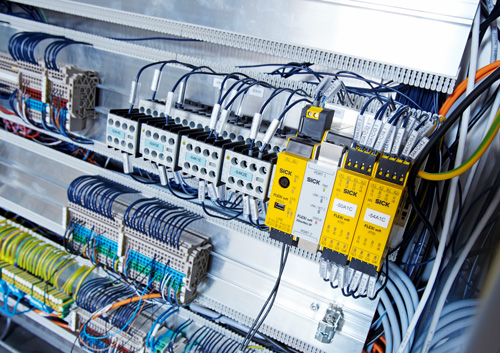It’s good to know that dangers can be kept hidden behind closed doors. But if someone does stray into a dangerous area, it’s also good to have safety systems that will reliably detect this – preventing injuries caused by machine movements. The range of safety functions out there is many and varied, and so too are the components that are available in the automation market. But with all eyes now firmly fixed on Industry 4.0, the question for safety technology applications is how flexible the interaction between sensor technology and actuator engineering will need to be in the future. 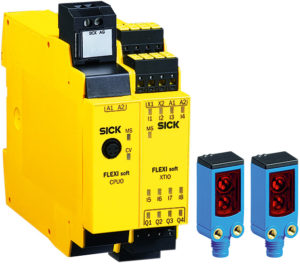 And how much intelligence will be needed in order to make adaptations in line with dynamically changing production conditions? The Safeguard Detector safety system from SICK reveals exactly what this approach involves in practice.
And how much intelligence will be needed in order to make adaptations in line with dynamically changing production conditions? The Safeguard Detector safety system from SICK reveals exactly what this approach involves in practice.
Safe, but also smart
The Safeguard Detector is a complete safety solution that is easy to implement in packaging machines – for monitoring material transportation on carton magazines, for example. There are conventional methods available for protecting hazardous areas, including mechanical tunnel covers combined with safety switches. However, this method restricts the machine operator’s access, limiting both accessibility and flexibility. A much more sophisticated and productive method is to secure the hazardous area in such a way that access can only be gained when the carton magazine falls below a specific minimum fill level.
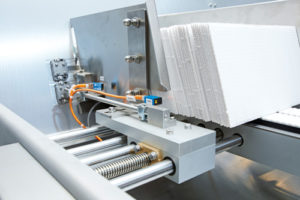
The Safeguard Detector is one example of a complete safety solution for certain applications. It contains everything that is necessary for implementing a specific safety function in an actual application. This includes the safety controller as well as project planning software, safety characteristic value calculations, circuit diagrams, installation materials, and sensors – which, in this particular example, monitor the magazine level. In addition, safety systems such as the Safeguard Detector is TÜV-approved and reaches the safety level required for an application in a way that is tailored for use with packaging machines.
Prepared and approved
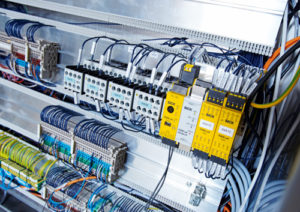 SICK takes this concept even further. Safety Systems provide solutions for typical safety functions that need to be applied over and over again. The packages are configured so that customers can order all the materials they need for installation using a single part number. This part number does not simply represent the individual sensor, or a controller or the connection cable – instead, it represents everything that is needed for the application in question: hardware, operating instructions, training, certificates, plus technical data and software. With everything including certification provided ready-prepared, SICK makes the machine engineer’s work easier and faster.
SICK takes this concept even further. Safety Systems provide solutions for typical safety functions that need to be applied over and over again. The packages are configured so that customers can order all the materials they need for installation using a single part number. This part number does not simply represent the individual sensor, or a controller or the connection cable – instead, it represents everything that is needed for the application in question: hardware, operating instructions, training, certificates, plus technical data and software. With everything including certification provided ready-prepared, SICK makes the machine engineer’s work easier and faster.
Modernization: Fast solutions with manufacturer knowledge
SICK’s strategy for safety technology, favoring a view of the system as a whole rather than focusing purely on individual components, creates tangible advantages for operating entities too.
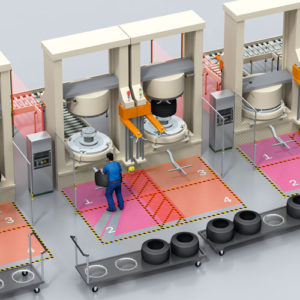 Safe Tire Curing Solutions is a solution for protecting the hazardous area of tire curing machines, which are used in tire production to shape and vulcanize green tires. Accidents occurring at these plants in the past have shown that the process is very hazardous. This results in a high risk of accidents occurring, particularly at tire curing machines that must be loaded manually by a worker. As a result, new machines should meet the requirements of EN 16474 Tire Curing Machines – Safety Requirements and are therefore being equipped with more advanced safety technology by machine manufacturers. But what about older plant models?
Safe Tire Curing Solutions is a solution for protecting the hazardous area of tire curing machines, which are used in tire production to shape and vulcanize green tires. Accidents occurring at these plants in the past have shown that the process is very hazardous. This results in a high risk of accidents occurring, particularly at tire curing machines that must be loaded manually by a worker. As a result, new machines should meet the requirements of EN 16474 Tire Curing Machines – Safety Requirements and are therefore being equipped with more advanced safety technology by machine manufacturers. But what about older plant models?
This is where the SICK strategy comes in. It aims to take a more consistently solutions-based approach to safety technology and examine the specific challenges posed by an application. Existing plants can therefore be retrofitted quickly and routinely by experienced SICK specialists, so there is no need for customers to tie up their own resources in the process. The service portfolio includes the initial risk analysis, the safety concept, the safety hardware and software design, the installation, as well as the commissioning and validation processes.
Safety solutions at system level
Safety technology in mechanical and plant engineering is an exacting discipline. It requires in-depth specialist expertise and a constant awareness of the standards that are currently in force. That is why it makes sense for mechanical and plant engineers to seek out the advice of safety experts in this context. SICK’s safety services allow existing plants facing modernization to be retrofitted in a way that is both fast and compliant with the relevant standards.


